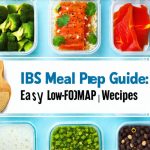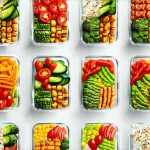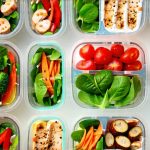The modern lifestyle often feels like a relentless race against time, leaving little room for mindful eating habits. We’re bombarded with convenience foods, busy schedules dictate quick (and often less-than-ideal) meal choices, and the result is frequently wasted food and compromised digestive health. Many individuals struggle with bloating, discomfort, or other digestive issues that are directly linked to dietary patterns – what we eat, how quickly we eat it, and whether our bodies can efficiently process it. This creates a vicious cycle: stress leads to poor eating habits, which exacerbate digestive problems, further increasing stress levels. Breaking this cycle requires intentionality, and one powerful approach is proactive meal preparation that not only saves time and money but also actively supports gut health and minimizes waste.
This isn’t about elaborate recipes or spending all weekend in the kitchen. It’s about strategically planning meals with both digestive wellness and resourcefulness in mind. We can reduce food waste by utilizing entire ingredients, embracing batch cooking to prevent impulse purchases, and understanding how different foods impact our individual digestive systems. Moreover, preparing meals allows us to control ingredient quality, opting for whole, unprocessed options that nourish the gut microbiome and promote optimal digestion. A thoughtful meal prep routine empowers us to take charge of both our health and our environmental footprint—a win-win scenario in a world increasingly focused on sustainability and wellbeing. If you struggle with identifying what might be causing digestive issues, consider recognizing food intolerances that may be impacting your system.
Building Blocks: Planning & Pantry Staples
Effective meal prepping begins long before you start chopping vegetables. It starts with planning – taking stock of what you already have, identifying meals that align with your dietary needs and preferences, and creating a shopping list based on those plans. Resist the urge to impulsively buy ingredients just because they look appealing; instead, focus on items you know you will use. A well-organized pantry is also crucial. Stocking up on staples reduces the need for frequent grocery trips and minimizes food waste.
Consider building your pantry around foods that are known to support digestive health. This doesn’t mean eliminating all “fun” foods; it means prioritizing ingredients that are gentle on the gut and promote a healthy microbiome. Examples include: – Oats (gluten-free if necessary) – Quinoa – Brown rice – Lentils & other legumes – Sweet potatoes – Bananas (ripe, for easy digestion) – Ginger & turmeric (fresh or powdered) – powerful anti-inflammatory spices. Having these readily available makes it easier to create nourishing meals quickly and efficiently. You can also learn more about preparing and seasoning your food in ways that minimize digestive upset.
Beyond pantry staples, think about how you can repurpose ingredients. Roasted vegetables from one meal can become a component of another—added to salads, frittatas, or soups. Leftover cooked grains can be transformed into grain bowls or breakfast porridge. This level of resourcefulness not only reduces waste but also simplifies your cooking process. Remember that flexibility is key; don’t feel constrained by rigid meal plans if unexpected events arise. The goal is to create a sustainable system, not an overwhelming obligation.
Utilizing the Whole Ingredient Philosophy
One of the biggest contributors to food waste is discarding edible parts of ingredients. Many fruits and vegetables have perfectly nutritious peels, stems, and leaves that we often throw away without a second thought. Embracing the “whole ingredient” philosophy means finding ways to use every part of the produce you buy. For example: – Broccoli stalks can be grated into salads or stir-fries. – Beet greens are delicious sautéed like spinach. – Carrot tops make fantastic pesto. – Apple peels can be used to make a flavorful tea.
This approach isn’t just environmentally friendly; it also boosts the nutritional value of your meals. Peels and stems often contain concentrated amounts of vitamins, minerals, and fiber. Furthermore, using entire ingredients challenges us to think creatively in the kitchen and expand our culinary repertoire. It’s about shifting our mindset from simply consuming a product to appreciating the full potential of the food we bring into our homes. This mindful approach connects us more deeply to our food sources and fosters a greater sense of respect for resources. Understanding foods that trigger bloating can help you make more informed choices when preparing meals, too.
Batch Cooking & Freezer-Friendly Meals
Batch cooking – preparing large quantities of food at once – is a game-changer for both time management and reducing waste. Dedicate a few hours on the weekend (or whenever you have free time) to cook several meals or components that can be used throughout the week. This eliminates the need to cook every night, saving valuable time and energy. Focus on meals that are easily scalable and reheat well – soups, stews, casseroles, roasted vegetables, and cooked grains are all excellent options.
The freezer is your ally in this endeavor. Many foods freeze exceptionally well, extending their shelf life and allowing you to save leftovers for future meals. Portion out individual servings into reusable containers or freezer bags before freezing, making it easy to grab exactly what you need when you’re short on time. Labeling containers with the date and contents is essential to avoid “freezer burn” and forgotten treasures. Consider freezing: – Soups & stews – Cooked grains (rice, quinoa) – Roasted vegetables – Smoothies (pre-portioned ingredients) – a great grab-and-go breakfast option. Proper posture during meals can also aid in digestion and comfort when enjoying your prepped food!
Gentle Digestion Through Food Preparation Techniques
How we prepare food significantly impacts its digestibility. Certain cooking methods can make foods easier for our bodies to break down and absorb nutrients. For instance, steaming vegetables preserves more nutrients than boiling and makes them softer and easier to digest. Similarly, soaking legumes overnight reduces their phytic acid content, making them less likely to cause bloating or gas. Incorporating healthy fats – such as olive oil, avocado, or nuts – can also aid digestion by slowing down the absorption of carbohydrates.
When meal prepping, consider incorporating techniques that promote gentle digestion. This might involve lightly sautéing vegetables in olive oil, adding a pinch of ginger or turmeric to soups, or using spices known for their digestive benefits, like fennel seeds or caraway. Avoiding overly processed foods and focusing on whole, natural ingredients is also crucial. Remember that everyone’s digestive system is different; pay attention to how your body responds to various foods and adjust your meal prep accordingly. If certain ingredients consistently cause discomfort, experiment with alternatives or reduce your portion sizes. You might even find natural remedies and herbs that can help alleviate mild discomfort too, while you continue to refine your meal prep routines. To further support balanced digestion, consider planning balanced meals.


















